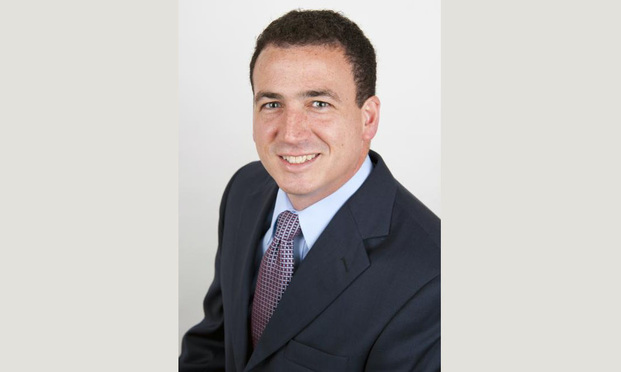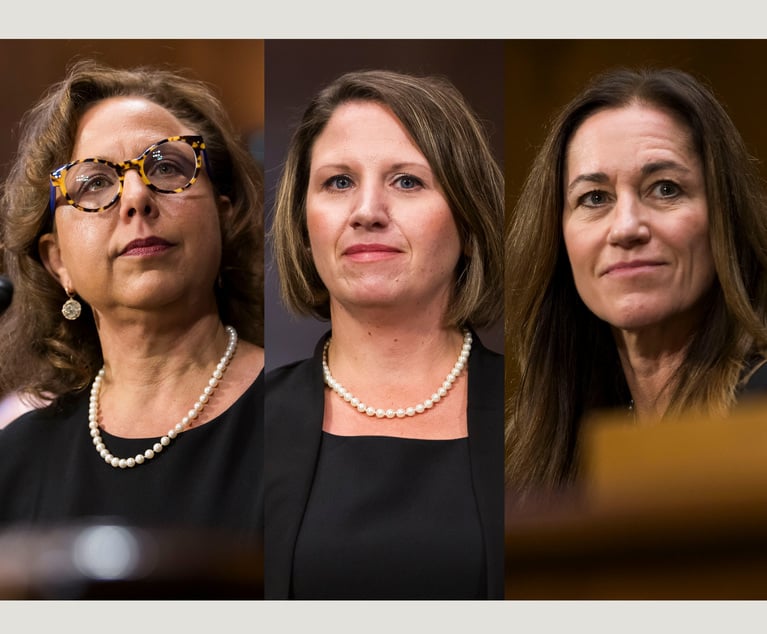A Recipe for Risk—Last-Minute Tax Planning for Estates
Estate planning strategies such as family limited partnerships and gifts to charitable trusts are part of an estate planning professional's toolbox to achieve client goals such as minimizing taxes, effectuating philanthropic plans, teaching younger generations about a family business and passing on wealth.
May 18, 2020 at 12:37 PM
11 minute read
 Joseph Frabizzio of Robson and Robson.
Joseph Frabizzio of Robson and Robson.Estate planning strategies such as family limited partnerships and gifts to charitable trusts are part of an estate planning professional's toolbox to achieve client goals such as minimizing taxes, effectuating philanthropic plans, teaching younger generations about a family business and passing on wealth. In the best-case scenario, attorneys and their clients have time to review how the plan will work, allow younger generations to evaluate their role in the plan, evaluate the goals it will achieve, and recognize any risks associated with the plan. Whether a client's estate is of a significant amount or of a more modest size, recent experience with COVID-19 highlights the need for individuals to take care of their planning while they have time to consider all issues involved versus rushing to implement a plan when there is a serious illness or fear of one driving their actions. These concerns are magnified, of course, when one must consider federal estate and gift tax issues. A recent memorandum opinion by the U.S. Tax Court provides an example of a last-minute, complex plan that may have been doomed from the start or headed off the rails in its implementation. See Estate of Howard V. Moore v. Commissioner of Internal Revenue, Docket Nos. 21209-09, 22082-09 (U.S. Tax Ct. April 7, 2020).
Background
Howard Moore, the decedent, owned a large amount of property and operated a successful farm. Moore was admitted to the hospital with a critical illness in December 2004 and was discharged to hospice care that same month with advice that he only had a short time to live. Within a matter of days, Moore contacted an attorney who was able to design an estate plan consisting of a family limited partnership (FLP), a living trust, a charitable lead annuity trust, a trust for his adult children, a management trust that acted as the general partner of the FLP and an "Irrevocable Trust No. 1"designed to act as a conduit for the transfer of funds from the FLP to a charitable foundation. The decedent survived for a few months after creating these entities, but succumbed to his illness in March 2005. At the time he died, assuming no taxable gifts during a person's lifetime, the amount excluded from federal estate tax for an individual amounted to $1,5 million. With somewhere between $8 to $20 million in his estate and a top estate tax rate of 47% at the time, the goal of saving estate taxes must have seemed important enough to pay his attorney $320,000 for designing the plan.
The primary thrust of the planning included a transfer of the farm to a living trust and a subsequent transfer of 80% of the farm property to the FLP. A management trust established by the decedent acted as general partner of the FLP, with the decedent's living trust owning 95% of the limited partnership interests and each of the decedent's children each owning a 1% limited partnership interest. The decedent's estate and his family later asserted that the purpose of the FLP was to offer protection against liabilities from the use of pesticides, health risks to workers, creditors and potential bad marriages of the decedent's offspring. Another reason for forming the FLP was to bring the "dysfunctional" family together since they would be required to jointly manage the FLP and its property. The FLP contained transfer restrictions and the limited partners had no right to participate in business management or operation decisions regarding the FLP.
The trust known as Irrevocable Trust No. 1 was nominally funded at the time of decedent's death and thereafter received funds from the FLP. In turn, those funds were transferred to the charitable trust in pursuit of a charitable deduction by the estate. Shortly before the decedent's death, Moore had also used FLP funds to make significant transfers to his children that were designated as loans, as well as making outright gifts to his children and a grandson.
Tax Court Analysis
The decedent's estate filed an estate tax return and a gift tax return after his death. Following review of the returns, the Internal Revenue Service (IRS) issued a notice of deficiency of almost $6.4 million. The tax court, which issued its opinion on April 7, agreed in large part with the IRS findings that the decedent's plan to save estate taxes was ineffective. The court viewed the estate's arguments as one of form over substance, in which the only recognizable goal of the transactions entered into before the decedent's death was to save estate taxes. While the opinion does not specify what caused the IRS to audit the return, it is apparent that the intense planning and creation of various entities within a short time before the decedent's death raised questions.
Federal estate taxes are imposed on the taxable estate of a decedent, which includes the value of property in which the decedent owned an interest at the time of death, less appropriate deductions. While assets transferred from the decedent to others prior to death may escape inclusion in the taxable estate, various statutory provisions pull some transfers back into the taxable estate. We will focus on the transfer to the FLP and also address the loans to decedent's children and the IRS rejection of a deduction for a transfer of over $4 million to the charitable trust.
The decedent and his attorney were faced with several hurdles after learning of decedent's terminal illness in December 2004. The most significant asset in the estate, the farm, was already the subject of negotiations for sale to a neighbor. While these negotiations were ongoing, the decedent transferred the farm to his living trust and then transferred 80% of the farm from the living trust to the FLP. Notably, a contract to sell the farm was executed within days of transferring it to the living trust. In making such transfers, decedent and his attorney had to consider Section 2036 of the Internal Revenue Code. Section 2036 pulls back any transfers made by the decedent into the taxable estate, except those that are bona fide sales for adequate consideration. It also pulls back any transfers that are made where the decedent retains the right to possession or enjoyment of the property. Under Moore's plan, the decedent transferred the farm to his living trust in December 2004, transferred 80% of it to the FLP in December 2004 and entered into a contract to sell the farm for over $16 million within days of these transfers. This sale of the farm from the FLP to a third party closed in February 2005. At the same time, the living trust distributed $500,000 to Irrevocable Trust No. 1, which was reported as a gift to the decedent's children. A short time later, the living trust then transferred all of its interest in the FLP to the Irrevocable Trust No. 1 in exchange for $500,000 in cash and a $4.8 million promissory note. There was no record of how this value was set and the trust never made principal or interest payments to the FLP.
This estate purported that this series of transfers and sales resulted in inclusion of only a small portion of the FLP's value in the decedent's taxable estate. Essentially, the estate took the position that only the 1% general partnership interest and the $4.8 million note were included in the decedent's taxable estate and that all other value from the sale of the farm was removed from the taxable estate through these transactions. The court disagreed with this position. First, it concluded that there was no bona fide sale to the FLP for full and adequate consideration since there were no "nontax" reason for transferring the farm to the FLP. The decedent made the transfer knowing that it would be sold and would not require active management. While the estate also argued that the transfer occurred to protect the assets from creditors, the tax court found that there was no credible evidence of possible claims or threats of litigation. The tax court also gave weight to the decedent's ill health and creation of the complex estate plans within days after discharge from the hospital. Further, the court pointed out that the decedent made the decision to name his children limited partners in the FLP with no input from them or examination of the restrictions imposed on them by the FLP. The court concluded that all decisions about the FLP after its formation, despite appointing two of Moore's children as trustees of the management trust/GP, were made unilaterally by the decedent.
As an alternative holding, the tax court concluded that the transfers were includable under Section 2036 because the decedent retained possession or enjoyment of the portion of the farm transferred to the FLP. The IRS takes the position that transferring all or almost all of a decedent's assets during his lifetime is evidence of a retention of an interest in the transferred assets because a transferor would have no assets left to support him. While the decedent's attorney likely considered this argument by planning for decedent to retain a 20% interest in the farm through his living trust, the court found that the level of control decedent exercised over the transferred assets was problematic. For example, the decedent used FLP assets to pay personal expenses, continued to live on the farm, used FLP assets to make gifts/loans to his children and paid a large part of his attorney's fees out of the FLP. In the court's view, these factors added up to an understanding that decedent would continue to have access to the FLP funds as needed. Therefore, under either the non-bona fide sale or retention of possession or enjoyment arguments, a portion of the assets of the FLP should have been included in the decedent's taxable estate under Section 2036.
While the FLP analysis was the main thrust of the opinion, the Tax Court also rejected the characterization of the $500,000 transfers to each of the decedent's children as loans, finding that they were gifts from the decedent using FLP assets. The court also rejected a charitable deduction claimed by the estate because it concluded that gifts to be made to the charitable trust after decedent's death were not ascertainable at the decedent's death, but instead based on a formula clause that would only occur if the IRS successfully determined that additional amounts should be included in the taxable estate. As a final matter, the tax court also disallowed a deduction for $475,000 in attorney fees for administration of the estate because the estate failed to produce evidence of the work the attorney had done to administer the estate and justify the fee.
The decedent and his attorney were faced with a difficult situation. The decedent knew he had less than six months to live, had not accomplished any prior estate planning and was in the middle of negotiations to sell the most valuable asset in his estate. If Moore had engaged in planning five or ten years before his death, his attorney could have drafted a plan in which the substance and execution were sound and saved the estate millions of dollars in taxes. By waiting until such a late stage, they were left with a plan that attempted to recognize established transfer requirements without a favorable opportunity of satisfying them. It is unknown whether the matter will be appealed.
Joseph N. Frabizzio is of counsel at Robson & Robson where he focuses his practice on tax planning and controversy. Frabizzio holds an LL.M. in taxation and helps clients minimize their federal and state tax obligations associated with business transactions. He also assists clients with complex trusts and estates issues and succession planning. Frabizzio can be reached at 610-825-3009 or [email protected].
This content has been archived. It is available through our partners, LexisNexis® and Bloomberg Law.
To view this content, please continue to their sites.
Not a Lexis Subscriber?
Subscribe Now
Not a Bloomberg Law Subscriber?
Subscribe Now
NOT FOR REPRINT
© 2025 ALM Global, LLC, All Rights Reserved. Request academic re-use from www.copyright.com. All other uses, submit a request to [email protected]. For more information visit Asset & Logo Licensing.
You Might Like
View All
Pa. Federal District Courts Reach Full Complement Following Latest Confirmation

The Defense Bar Is Feeling the Strain: Busy Med Mal Trial Schedules Might Be Phila.'s 'New Normal'
7 minute read
Federal Judge Allows Elderly Woman's Consumer Protection Suit to Proceed Against Citizens Bank
5 minute read
Judge Leaves Statute of Limitations Question in Injury Crash Suit for a Jury
4 minute readTrending Stories
- 1Pa. High Court: Concrete Proof Not Needed to Weigh Grounds for Preliminary Injunction Order
- 2'Something Else Is Coming': DOGE Established, but With Limited Scope
- 3Polsinelli Picks Up Corporate Health Care Partner From Greenberg Traurig in LA
- 4Kirkland Lands in Phila., but Rate Pressure May Limit the High-Flying Firm's Growth Prospects
- 5Davis Wright Tremaine Turns to Gen AI To Teach Its Associates Legal Writing
Who Got The Work
J. Brugh Lower of Gibbons has entered an appearance for industrial equipment supplier Devco Corporation in a pending trademark infringement lawsuit. The suit, accusing the defendant of selling knock-off Graco products, was filed Dec. 18 in New Jersey District Court by Rivkin Radler on behalf of Graco Inc. and Graco Minnesota. The case, assigned to U.S. District Judge Zahid N. Quraishi, is 3:24-cv-11294, Graco Inc. et al v. Devco Corporation.
Who Got The Work
Rebecca Maller-Stein and Kent A. Yalowitz of Arnold & Porter Kaye Scholer have entered their appearances for Hanaco Venture Capital and its executives, Lior Prosor and David Frankel, in a pending securities lawsuit. The action, filed on Dec. 24 in New York Southern District Court by Zell, Aron & Co. on behalf of Goldeneye Advisors, accuses the defendants of negligently and fraudulently managing the plaintiff's $1 million investment. The case, assigned to U.S. District Judge Vernon S. Broderick, is 1:24-cv-09918, Goldeneye Advisors, LLC v. Hanaco Venture Capital, Ltd. et al.
Who Got The Work
Attorneys from A&O Shearman has stepped in as defense counsel for Toronto-Dominion Bank and other defendants in a pending securities class action. The suit, filed Dec. 11 in New York Southern District Court by Bleichmar Fonti & Auld, accuses the defendants of concealing the bank's 'pervasive' deficiencies in regards to its compliance with the Bank Secrecy Act and the quality of its anti-money laundering controls. The case, assigned to U.S. District Judge Arun Subramanian, is 1:24-cv-09445, Gonzalez v. The Toronto-Dominion Bank et al.
Who Got The Work
Crown Castle International, a Pennsylvania company providing shared communications infrastructure, has turned to Luke D. Wolf of Gordon Rees Scully Mansukhani to fend off a pending breach-of-contract lawsuit. The court action, filed Nov. 25 in Michigan Eastern District Court by Hooper Hathaway PC on behalf of The Town Residences LLC, accuses Crown Castle of failing to transfer approximately $30,000 in utility payments from T-Mobile in breach of a roof-top lease and assignment agreement. The case, assigned to U.S. District Judge Susan K. Declercq, is 2:24-cv-13131, The Town Residences LLC v. T-Mobile US, Inc. et al.
Who Got The Work
Wilfred P. Coronato and Daniel M. Schwartz of McCarter & English have stepped in as defense counsel to Electrolux Home Products Inc. in a pending product liability lawsuit. The court action, filed Nov. 26 in New York Eastern District Court by Poulos Lopiccolo PC and Nagel Rice LLP on behalf of David Stern, alleges that the defendant's refrigerators’ drawers and shelving repeatedly break and fall apart within months after purchase. The case, assigned to U.S. District Judge Joan M. Azrack, is 2:24-cv-08204, Stern v. Electrolux Home Products, Inc.
Featured Firms
Law Offices of Gary Martin Hays & Associates, P.C.
(470) 294-1674
Law Offices of Mark E. Salomone
(857) 444-6468
Smith & Hassler
(713) 739-1250





